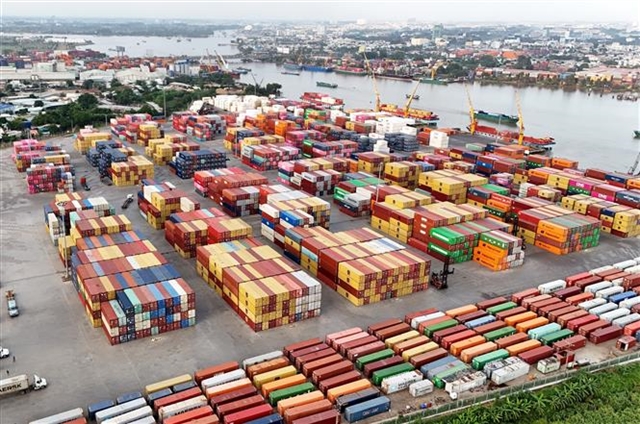Việt Nam maintains steady growth outlook despite trade headwinds: insights from AREO 2025
Despite growing uncertainty in global trade, Việt Nam is on track to maintain solid economic growth through 2025 and beyond, according to the latest ASEAN+3 Regional Economic Outlook (AREO) from the ASEAN+3 Macroeconomic Research Office (AMRO).

HÀ NỘI — Despite an increasingly uncertain global trade environment, Việt Nam is expected to maintain a steady economic growth trajectory in 2025 and beyond, according to the ASEAN+3 Regional Economic Outlook (AREO) 2025, released by the ASEAN+3 Macroeconomic Research Office (AMRO).
At the AMRO outreach seminar, co-hosted with the Foreign Trade University (FTU) on Monday in Hà Nội, Allen Ng, AMRO’s Group Head and Principal Economist emphasised Việt Nam's economic resilience, stating "Việt Nam continues to demonstrate remarkable resilience, with strong domestic demand serving as the main driver of growth despite mounting external challenges."
He highlighted that robust consumption and investment activities would help Việt Nam sustain growth even as the external environment becomes more volatile due to sweeping US tariff measures and rising geopolitical uncertainties.
The AREO 2025 report indicated that Việt Nam, along with several ASEAN economies, benefits from a more diversified trade structure compared to the past. Although exports to the US remain important, Việt Nam has increasingly shifted towards intraregional trade, particularly with China and other ASEAN countries. This structural shift is seen as a key factor that will help buffer the economy against protectionist shocks emanating from the US.
However, Việt Nam is not immune to the broader headwinds facing the region. The report warned that new US tariffs, announced in early April, could disproportionately impact ASEAN+3 economies, with Việt Nam and Cambodia among the most affected. AMRO’s estimates suggested that Việt Nam’s effective tariffs could impact around 4 per cent of its GDP, higher than the regional average
"While Việt Nam has managed to reduce its dependence on the US market, the escalating trade tensions could still weigh on industrial production and exports," Allen Ng said. Nevertheless, he emphasised that Việt Nam’s strong domestic fundamentals, including a resilient labour market and steady credit growth, would provide a solid cushion.
Turning to fiscal developments, Eung Hyun Hong from AMRO’s Fiscal Surveillance Group presented the ASEAN+3 Fiscal Policy Report (AFPR) 2025, which highlighted the fiscal challenges and opportunities facing Việt Nam.
"Việt Nam's fiscal space has narrowed considerably after the pandemic, mainly due to rising public debt and high gross financing needs," Eung Hyun Hong emphasised. Despite improvements in fiscal balances in recent years, Việt Nam's fiscal position remains weaker compared to pre-pandemic levels.

The AFPR 2025 outlined that Việt Nam’s gross government debt ratio increased notably during the pandemic and remains elevated. This, coupled with substantial financing requirements, limits fiscal manoeuvrability, underlining the need for prudent fiscal management. Eung Hyun Hong recommended that "fiscal consolidation efforts must continue, with a careful calibration of revenue and expenditure measures to rebuild buffers and safeguard debt sustainability."
However, fiscal tightening must be balanced against the need to support growth. Given the resilience of domestic demand and ongoing structural transformation, Việt Nam is in a favourable position to pursue a gradual fiscal adjustment while maintaining targeted support for vulnerable sectors, especially amid heightened global uncertainty.
From a structural perspective, Việt Nam's medium-term growth prospects remain positive but hinge on continued productivity improvements and structural reforms.
Mr. Byunghoon Nam, who led the discussion on the inaugural Country Fiscal Review (CFR) on Việt Nam, noted, "A key concern is the declining tax-to-GDP ratio, which points to weaknesses in tax administration and the need for reforms to enhance revenue mobilisation."
According to the CFR findings, Việt Nam’s fiscal decentralisation system, while enabling greater autonomy for local governments, also brings challenges in terms of fiscal discipline and coordination between central and local authorities. Addressing these structural fiscal issues will be critical to ensuring the sustainability of public finances in the coming years.
Comparatively, within the ASEAN+3 region, Việt Nam remains among the economies with higher growth prospects, with AMRO forecasting GDP growth of around 6 per cent in 2025 under baseline scenarios
This is above the projected ASEAN+3 average of 4.2 per cent. Nonetheless, Việt Nam shares similar vulnerabilities with its regional peers, including exposure to external shocks, demographic transitions, and the imperative of adapting to global technological changes.
In the broader context, AMRO urged ASEAN+3 policymakers to maintain flexible and proactive policy stances amid rising protectionism and geoeconomic fragmentation. Việt Nam, with its dynamic economy and strategic position, is expected to continue playing an important role as a growth engine within the region. — VNS





